
Pisa is a city and comune in Tuscany, central Italy, straddling the Arno just before it empties into the Ligurian Sea. It is the capital city of the Province of Pisa. Although Pisa is known worldwide for its leaning tower, the city contains more than twenty other historic churches, several medieval palaces, and bridges across the Arno. Much of the city's architecture was financed from its history as one of the Italian maritime republics.

The Piazza dei Miracoli, formally known as Piazza del Duomo, is a walled 8.87-hectare area located in Pisa, Tuscany, Italy, recognized as an important centre of European medieval art and one of the finest architectural complexes in the world. Considered sacred by the Catholic Church, its owner, the square is dominated by four great religious edifices: the Pisa Cathedral, the Pisa Baptistry, the Campanile, and the Camposanto Monumentale. Partly paved and partly grassed, the Piazza dei Miracoli is also the site of the Ospedale Nuovo di Santo Spirito, which houses the Sinopias Museum and the Cathedral Museum.

Caravaggio is a town and comune in the province of Bergamo, in Lombardy, Italy, 40 kilometres (25 mi) east of Milan.

Santa Maria della Spina is a small church in the Italian city of Pisa. The church, erected around 1230 in the Pisan Gothic style, and enlarged after 1325, was originally known as Santa Maria di Pontenovo for the newer bridge that existed nearby, collapsed in the 15th century, and was never rebuilt.
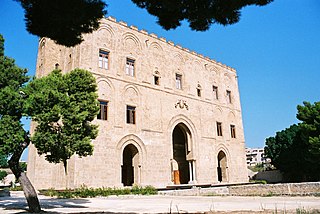
The Zisa is alternatively listed as either a castle or palace, and located in the western area of Palermo, region of Sicily, Italy. The edifice was begun around 1165 by an Moorish craftsman under the rule of the Norman conqueror of Sicily, king William I of Sicily. It was not finished until 1189, under the rule of William II. It is presently open to the public for tours.

Palazzo Madama e Casaforte degli Acaja is a palace in Turin, Piedmont. It was the first Senate of the Kingdom of Italy, and takes its traditional name from the embellishments it received under two queens (madama) of the House of Savoy.

The Ducal Palace, also known as Reggia di Colorno, is an edifice in the territory of Colorno, Emilia Romagna, Italy. It was built by Francesco Farnese, Duke of Parma in the early 18th century on the remains of a former castle.

Italy has a very broad and diverse architectural style, which cannot be simply classified by period or region, due to Italy's division into various small states until 1861. This has created a highly diverse and eclectic range in architectural designs. Italy is known for its considerable architectural achievements, such as the construction of aqueducts, temples and similar structures during ancient Rome, the founding of the Renaissance architectural movement in the late-14th to 16th century, and being the homeland of Palladianism, a style of construction which inspired movements such as that of Neoclassical architecture, and influenced the designs which noblemen built their country houses all over the world, notably in the United Kingdom, Australia and the United States of America during the late-17th to early 20th centuries.

Bodrum Mosque in Istanbul, Turkey, is a former Eastern Orthodox church converted into a mosque by the Ottomans. The church was known under the Greek name of Myrelaion.

San Piero a Grado is a church in Pisa, Tuscany, Italy, in the eponymous frazione 7 kilometres (4.3 mi) west of the city center. The church is located where once was a now disappeared port of the Pisan Republic, where, according to the legend, St. Peter landed in Italy from Antiochia in 44 AD.

San Nicola is a church in Pisa, Tuscany, Italy.

San Zeno is a church and a former abbey in Pisa, Tuscany, Italy.

Santa Caterina d'Alessandria is a Gothic-style, Roman Catholic church in Pisa, region of Tuscany, Italy.
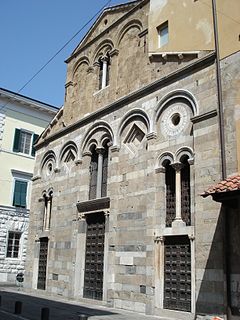
San Pietro in Vinculis is a Romanesque-style, Roman Catholic church in Pisa, region of Tuscany, Italy.
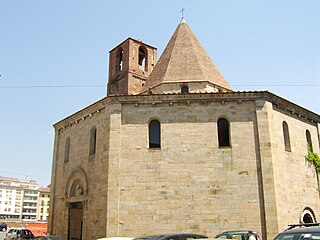
The Church of the Santo Sepolcro is a religious edifice in Pisa, Tuscany, Italy.
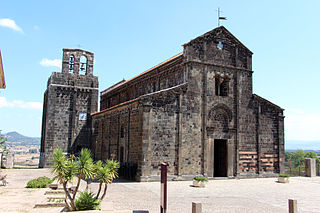
Santa Maria del Regno is a Romanesque church in Ardara, province of Sassari, Sardinia, Italy.

Palazzo Aragona Gonzaga is a 16th-century palace in Rome, Italy; it was once the residence of Cardinal Scipione Gonzaga. Today, its late Renaissance street facade bears plaques commemorating two of its residents, Saint Aloysius Gonzaga and the poet Torquato Tasso.

Palazzo dei Convertendi is a reconstructed Renaissance palace in Rome. It originally faced the Piazza Scossacavalli, but was demolished and rebuilt along the north side of Via della Conciliazione, the wide avenue constructed between 1936 and 1950, which links St Peter's Basilica and the Vatican City to the centre of Rome. The palace is famous as the last home of the painter Raphael, who died there in 1520.

The Palazzo Rusticucci-Accoramboni is a reconstructed late Renaissance palace in Rome. Erected by the will of Cardinal Girolamo Rusticucci, it was designed by Domenico Fontana and Carlo Maderno joining together several buildings already existing. Due to that, the building was not considered a good example of architecture. Originally lying along the north side of the Borgo Nuovo street, after 1667 the building faced the north side of the large new square located west of the new Saint Peter's Square, designed in those years by Gian Lorenzo Bernini. The square, named Piazza Rusticucci after the palace, was demolished in 1937–40 because of the erection of the new Via della Conciliazione. In 1940 the palace was dismantled and rebuilt with a different footprint along the north side of the new avenue, constructed between 1936 and 1950, which links St Peter's Basilica and the Vatican City to the center of Rome.
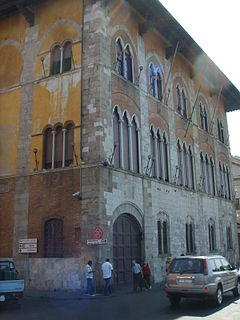
The Palazzo Vecchio de' Medici, also called the Palazzo della Prefettura is a Gothic revival-style palace located on Piazza Giuseppe Mazzini #7, in the city of Pisa, region of Tuscany, Italy.






















